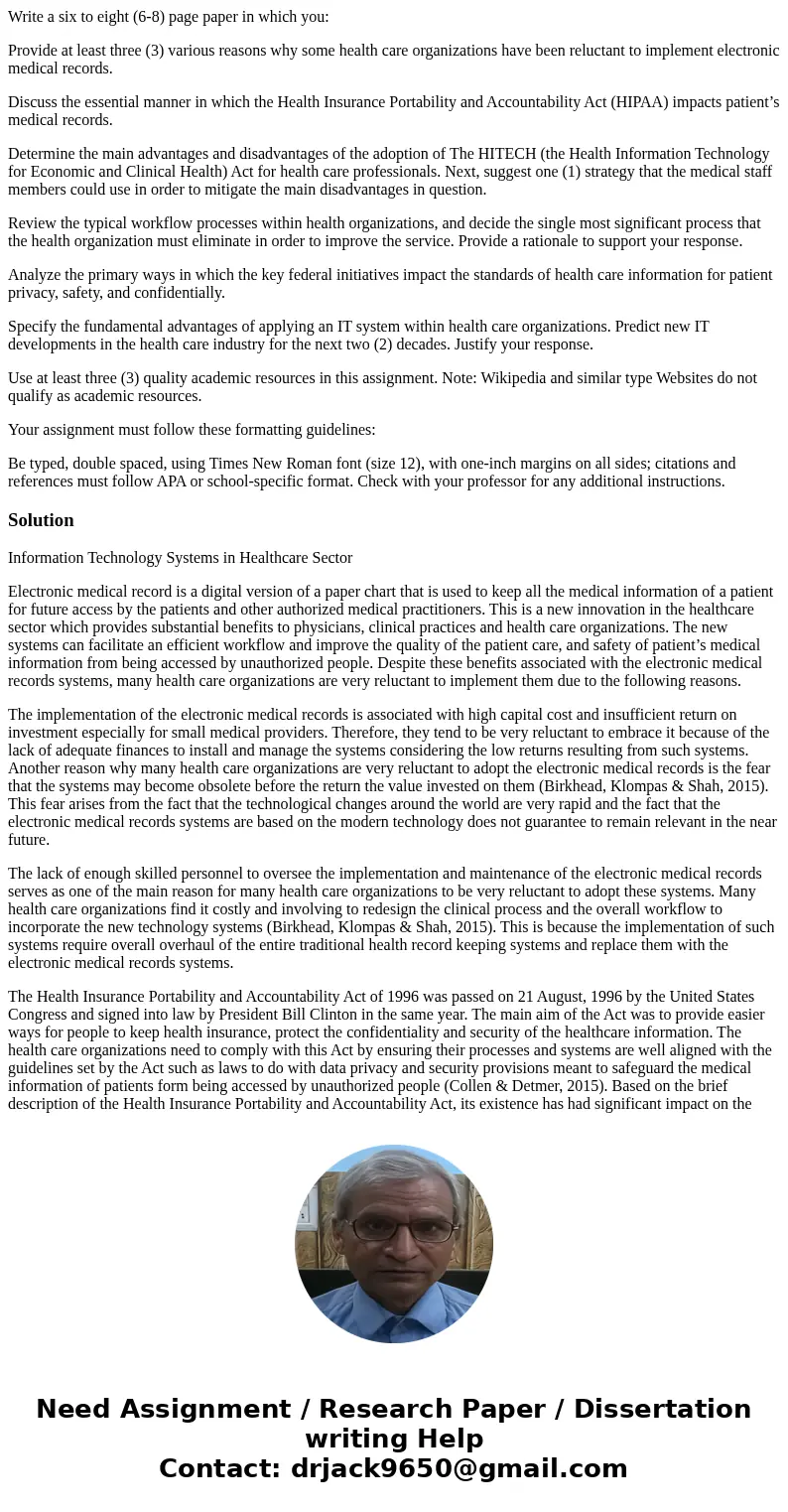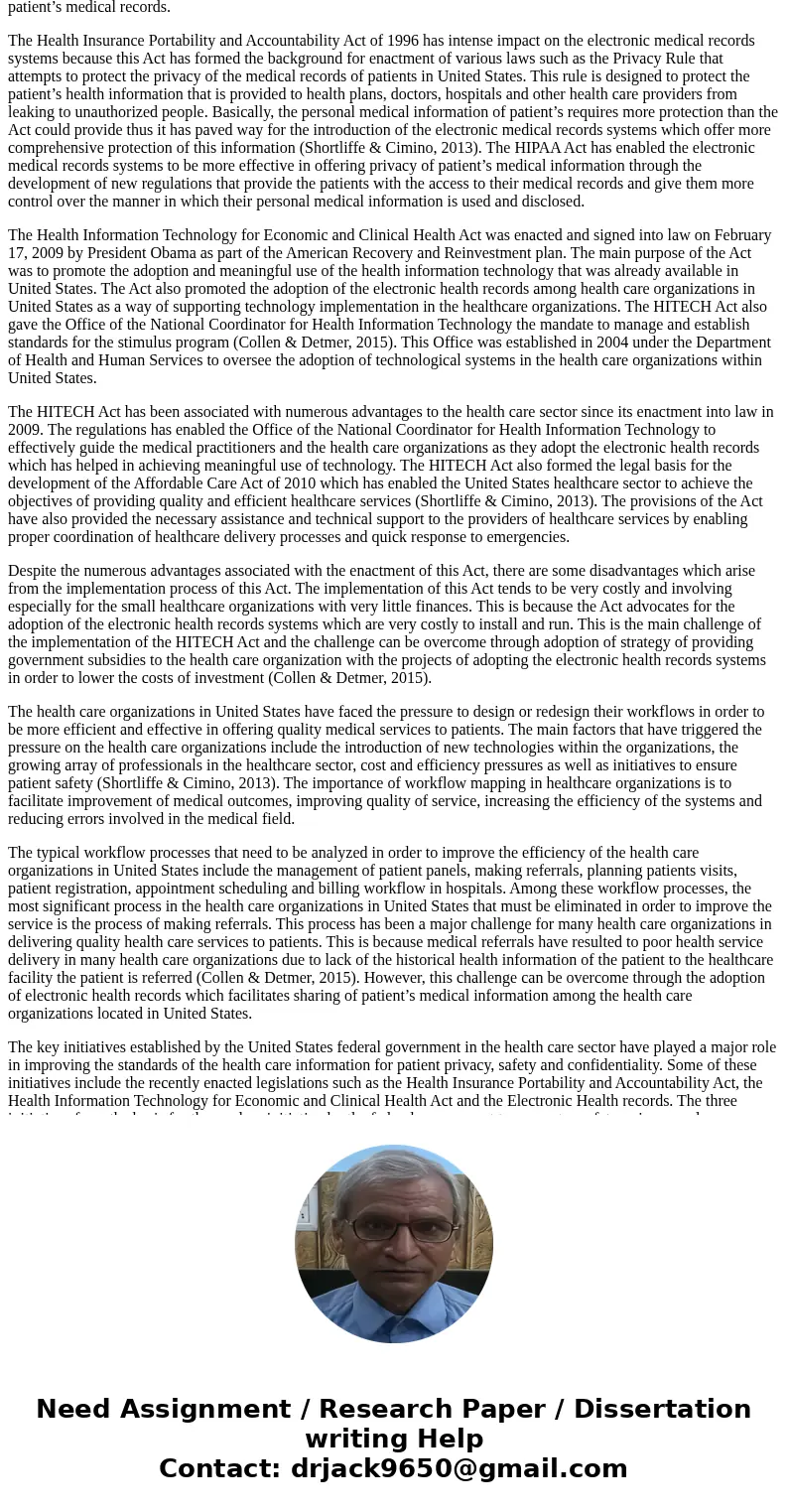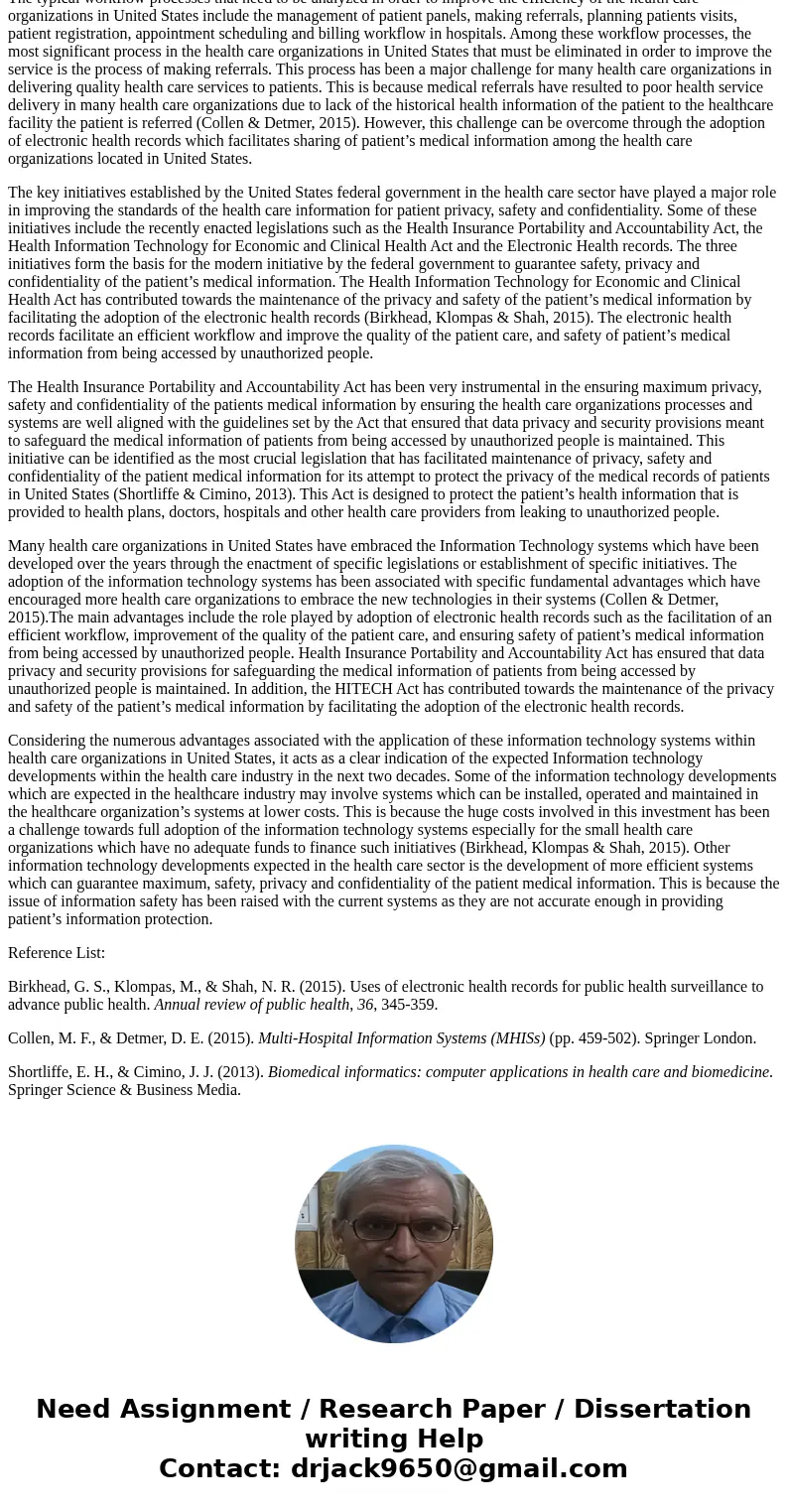Write a six to eight 68 page paper in which you Provide at l
Write a six to eight (6-8) page paper in which you:
Provide at least three (3) various reasons why some health care organizations have been reluctant to implement electronic medical records.
Discuss the essential manner in which the Health Insurance Portability and Accountability Act (HIPAA) impacts patient’s medical records.
Determine the main advantages and disadvantages of the adoption of The HITECH (the Health Information Technology for Economic and Clinical Health) Act for health care professionals. Next, suggest one (1) strategy that the medical staff members could use in order to mitigate the main disadvantages in question.
Review the typical workflow processes within health organizations, and decide the single most significant process that the health organization must eliminate in order to improve the service. Provide a rationale to support your response.
Analyze the primary ways in which the key federal initiatives impact the standards of health care information for patient privacy, safety, and confidentially.
Specify the fundamental advantages of applying an IT system within health care organizations. Predict new IT developments in the health care industry for the next two (2) decades. Justify your response.
Use at least three (3) quality academic resources in this assignment. Note: Wikipedia and similar type Websites do not qualify as academic resources.
Your assignment must follow these formatting guidelines:
Be typed, double spaced, using Times New Roman font (size 12), with one-inch margins on all sides; citations and references must follow APA or school-specific format. Check with your professor for any additional instructions.
Solution
Information Technology Systems in Healthcare Sector
Electronic medical record is a digital version of a paper chart that is used to keep all the medical information of a patient for future access by the patients and other authorized medical practitioners. This is a new innovation in the healthcare sector which provides substantial benefits to physicians, clinical practices and health care organizations. The new systems can facilitate an efficient workflow and improve the quality of the patient care, and safety of patient’s medical information from being accessed by unauthorized people. Despite these benefits associated with the electronic medical records systems, many health care organizations are very reluctant to implement them due to the following reasons.
The implementation of the electronic medical records is associated with high capital cost and insufficient return on investment especially for small medical providers. Therefore, they tend to be very reluctant to embrace it because of the lack of adequate finances to install and manage the systems considering the low returns resulting from such systems. Another reason why many health care organizations are very reluctant to adopt the electronic medical records is the fear that the systems may become obsolete before the return the value invested on them (Birkhead, Klompas & Shah, 2015). This fear arises from the fact that the technological changes around the world are very rapid and the fact that the electronic medical records systems are based on the modern technology does not guarantee to remain relevant in the near future.
The lack of enough skilled personnel to oversee the implementation and maintenance of the electronic medical records serves as one of the main reason for many health care organizations to be very reluctant to adopt these systems. Many health care organizations find it costly and involving to redesign the clinical process and the overall workflow to incorporate the new technology systems (Birkhead, Klompas & Shah, 2015). This is because the implementation of such systems require overall overhaul of the entire traditional health record keeping systems and replace them with the electronic medical records systems.
The Health Insurance Portability and Accountability Act of 1996 was passed on 21 August, 1996 by the United States Congress and signed into law by President Bill Clinton in the same year. The main aim of the Act was to provide easier ways for people to keep health insurance, protect the confidentiality and security of the healthcare information. The health care organizations need to comply with this Act by ensuring their processes and systems are well aligned with the guidelines set by the Act such as laws to do with data privacy and security provisions meant to safeguard the medical information of patients form being accessed by unauthorized people (Collen & Detmer, 2015). Based on the brief description of the Health Insurance Portability and Accountability Act, its existence has had significant impact on the patient’s medical records.
The Health Insurance Portability and Accountability Act of 1996 has intense impact on the electronic medical records systems because this Act has formed the background for enactment of various laws such as the Privacy Rule that attempts to protect the privacy of the medical records of patients in United States. This rule is designed to protect the patient’s health information that is provided to health plans, doctors, hospitals and other health care providers from leaking to unauthorized people. Basically, the personal medical information of patient’s requires more protection than the Act could provide thus it has paved way for the introduction of the electronic medical records systems which offer more comprehensive protection of this information (Shortliffe & Cimino, 2013). The HIPAA Act has enabled the electronic medical records systems to be more effective in offering privacy of patient’s medical information through the development of new regulations that provide the patients with the access to their medical records and give them more control over the manner in which their personal medical information is used and disclosed.
The Health Information Technology for Economic and Clinical Health Act was enacted and signed into law on February 17, 2009 by President Obama as part of the American Recovery and Reinvestment plan. The main purpose of the Act was to promote the adoption and meaningful use of the health information technology that was already available in United States. The Act also promoted the adoption of the electronic health records among health care organizations in United States as a way of supporting technology implementation in the healthcare organizations. The HITECH Act also gave the Office of the National Coordinator for Health Information Technology the mandate to manage and establish standards for the stimulus program (Collen & Detmer, 2015). This Office was established in 2004 under the Department of Health and Human Services to oversee the adoption of technological systems in the health care organizations within United States.
The HITECH Act has been associated with numerous advantages to the health care sector since its enactment into law in 2009. The regulations has enabled the Office of the National Coordinator for Health Information Technology to effectively guide the medical practitioners and the health care organizations as they adopt the electronic health records which has helped in achieving meaningful use of technology. The HITECH Act also formed the legal basis for the development of the Affordable Care Act of 2010 which has enabled the United States healthcare sector to achieve the objectives of providing quality and efficient healthcare services (Shortliffe & Cimino, 2013). The provisions of the Act have also provided the necessary assistance and technical support to the providers of healthcare services by enabling proper coordination of healthcare delivery processes and quick response to emergencies.
Despite the numerous advantages associated with the enactment of this Act, there are some disadvantages which arise from the implementation process of this Act. The implementation of this Act tends to be very costly and involving especially for the small healthcare organizations with very little finances. This is because the Act advocates for the adoption of the electronic health records systems which are very costly to install and run. This is the main challenge of the implementation of the HITECH Act and the challenge can be overcome through adoption of strategy of providing government subsidies to the health care organization with the projects of adopting the electronic health records systems in order to lower the costs of investment (Collen & Detmer, 2015).
The health care organizations in United States have faced the pressure to design or redesign their workflows in order to be more efficient and effective in offering quality medical services to patients. The main factors that have triggered the pressure on the health care organizations include the introduction of new technologies within the organizations, the growing array of professionals in the healthcare sector, cost and efficiency pressures as well as initiatives to ensure patient safety (Shortliffe & Cimino, 2013). The importance of workflow mapping in healthcare organizations is to facilitate improvement of medical outcomes, improving quality of service, increasing the efficiency of the systems and reducing errors involved in the medical field.
The typical workflow processes that need to be analyzed in order to improve the efficiency of the health care organizations in United States include the management of patient panels, making referrals, planning patients visits, patient registration, appointment scheduling and billing workflow in hospitals. Among these workflow processes, the most significant process in the health care organizations in United States that must be eliminated in order to improve the service is the process of making referrals. This process has been a major challenge for many health care organizations in delivering quality health care services to patients. This is because medical referrals have resulted to poor health service delivery in many health care organizations due to lack of the historical health information of the patient to the healthcare facility the patient is referred (Collen & Detmer, 2015). However, this challenge can be overcome through the adoption of electronic health records which facilitates sharing of patient’s medical information among the health care organizations located in United States.
The key initiatives established by the United States federal government in the health care sector have played a major role in improving the standards of the health care information for patient privacy, safety and confidentiality. Some of these initiatives include the recently enacted legislations such as the Health Insurance Portability and Accountability Act, the Health Information Technology for Economic and Clinical Health Act and the Electronic Health records. The three initiatives form the basis for the modern initiative by the federal government to guarantee safety, privacy and confidentiality of the patient’s medical information. The Health Information Technology for Economic and Clinical Health Act has contributed towards the maintenance of the privacy and safety of the patient’s medical information by facilitating the adoption of the electronic health records (Birkhead, Klompas & Shah, 2015). The electronic health records facilitate an efficient workflow and improve the quality of the patient care, and safety of patient’s medical information from being accessed by unauthorized people.
The Health Insurance Portability and Accountability Act has been very instrumental in the ensuring maximum privacy, safety and confidentiality of the patients medical information by ensuring the health care organizations processes and systems are well aligned with the guidelines set by the Act that ensured that data privacy and security provisions meant to safeguard the medical information of patients from being accessed by unauthorized people is maintained. This initiative can be identified as the most crucial legislation that has facilitated maintenance of privacy, safety and confidentiality of the patient medical information for its attempt to protect the privacy of the medical records of patients in United States (Shortliffe & Cimino, 2013). This Act is designed to protect the patient’s health information that is provided to health plans, doctors, hospitals and other health care providers from leaking to unauthorized people.
Many health care organizations in United States have embraced the Information Technology systems which have been developed over the years through the enactment of specific legislations or establishment of specific initiatives. The adoption of the information technology systems has been associated with specific fundamental advantages which have encouraged more health care organizations to embrace the new technologies in their systems (Collen & Detmer, 2015).The main advantages include the role played by adoption of electronic health records such as the facilitation of an efficient workflow, improvement of the quality of the patient care, and ensuring safety of patient’s medical information from being accessed by unauthorized people. Health Insurance Portability and Accountability Act has ensured that data privacy and security provisions for safeguarding the medical information of patients from being accessed by unauthorized people is maintained. In addition, the HITECH Act has contributed towards the maintenance of the privacy and safety of the patient’s medical information by facilitating the adoption of the electronic health records.
Considering the numerous advantages associated with the application of these information technology systems within health care organizations in United States, it acts as a clear indication of the expected Information technology developments within the health care industry in the next two decades. Some of the information technology developments which are expected in the healthcare industry may involve systems which can be installed, operated and maintained in the healthcare organization’s systems at lower costs. This is because the huge costs involved in this investment has been a challenge towards full adoption of the information technology systems especially for the small health care organizations which have no adequate funds to finance such initiatives (Birkhead, Klompas & Shah, 2015). Other information technology developments expected in the health care sector is the development of more efficient systems which can guarantee maximum, safety, privacy and confidentiality of the patient medical information. This is because the issue of information safety has been raised with the current systems as they are not accurate enough in providing patient’s information protection.
Reference List:
Birkhead, G. S., Klompas, M., & Shah, N. R. (2015). Uses of electronic health records for public health surveillance to advance public health. Annual review of public health, 36, 345-359.
Collen, M. F., & Detmer, D. E. (2015). Multi-Hospital Information Systems (MHISs) (pp. 459-502). Springer London.
Shortliffe, E. H., & Cimino, J. J. (2013). Biomedical informatics: computer applications in health care and biomedicine. Springer Science & Business Media.



 Homework Sourse
Homework Sourse